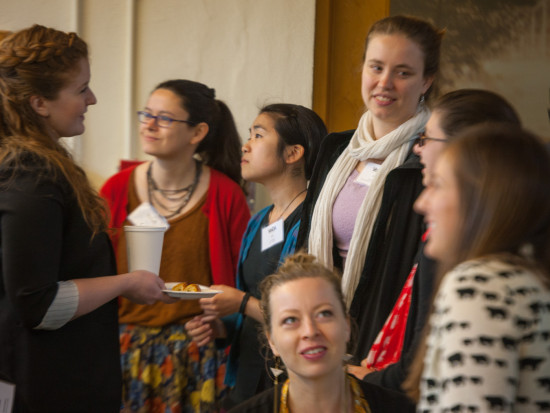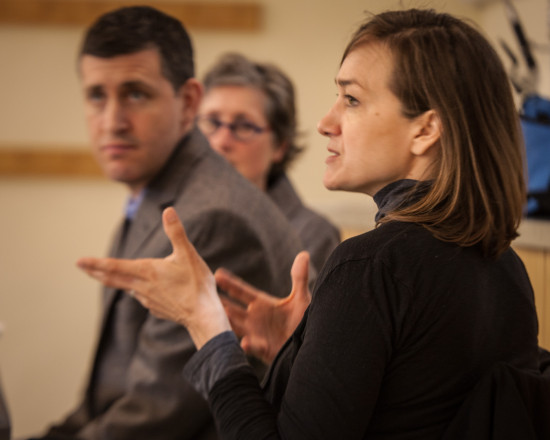Returning blogger Desi Peters is a 4th year graduate student at the Conservation Center of the Institute of Fine Arts, NYU. She is completing her graduate internship at the Smithsonian American Art Museum. She is interested in the conservation of Modern and Contemporary art and working with living artists.
Reflections on VoCA’s Artist Interview Workshop for ANAGPIC students: Winterthur Museum & Library, Sunday April 19, 2015
VoCA’s third annual Artist Interview Workshop for ANAGPIC students – and the organization’s first program since changing its name from INCCA-North America this past March – proved to be an elucidating exchange of experience and reflection. Occurring the day after the annual ANAGPIC (Association for North American Graduate Programs in Conservation) conference, the Workshop addressed the role of artist interviews in the conservation of modern and contemporary art. Participants were primarily selected from the various graduate programs attending the conference.
The day began with presentations by Gwynne Ryan, Sculpture Conservator at the Hirshhorn Museum & Sculpture Garden, Julie McGee, curator of African American Art & Associate Professor of Black American Studies at the University of Delaware, and Jess Rigelhaupt, associate professor of History and American Studies at the University of Mary Washington, followed by a roundtable discussion. Gwynne Ryan addressed the evolution of thought in Modern and Contemporary Art Conservation and identified what we actually mean when we say ‘interview’ (as distinguished from the other types of communication that occur by email, phone, etc). She shared tips for carrying out a successful interview and incorporated case studies as examples.
Julie McGee drew upon her extensive experience with contemporary African American art to highlight the biases at play during an interview. Through a discussion of an article given to the participants in advance of the workshop, she analyzed the ways in which the interviewer brings bias to the encounter and how that bias affects the type of information gleaned from the artist. She encouraged participants to shift their attention from the interviewee’s experience to their own experience as interviewers, and to be aware of the potential preconceptions that they may bring to the table. She emphasized the importance of word-choice and shared tips for phrasing questions in a way that is bias-free.
Jess Rigelhaupt identified ways to break the automatic narrative that is often given by interviewees who have been questioned frequently. Encouraging participants to consider why an interviewee might offer a scripted answer, he explained that interviews are a way of understanding what types of questions need to be asked. He stressed that interviews should be thought of on a continuum rather than as a singular event. He encouraged thematic organization — one that centers on general ideas rather than specific questions — and the use of silence as a tool, sharing the helpful tip that it takes eight seconds to develop a new critical thought.
Next was the round-table discussion, during which participants asked questions about how to sensitively discuss a work’s existence after the artist’s death or an artist’s awareness of conservation ethics and practice. Over lunch, participants were asked to interview someone they didn’t know and gather enough information to provide a one-minute introduction to the entire group. The goal was to gain the experience of doing an interview and being interviewed. The introductions varied, some were structured while others were less so. Participants shared a general feeling of exposure while their introductions were given to the entire group.

During a break in the agenda, students mingle and begin to apply some of the interviewing tools they’ve learned
The workshop closed with a final presentation by Gwynne Ryan in which she elucidated how artist interviews led to a treatment of Ann Hamilton’s Palimpsest (1989) that was originally never considered. The interviews identified a previously unrecognized performative aspect of the piece which was incorporated into the conservation treatment.
VoCA inaugurated its new name via the many voices of contemporary art that were expressed throughout this workshop as students, curators, conservators, and historians exchanged experiences and ideas. Specific examples illustrated the usefulness of artist interviews within conservation practice while the workshop overall emphasized that interviews are only one tool in a deep arsenal of strategies available to the conservator. The group activities in which participants interviewed each other allowed us to experience both sides of the interview process – the vulnerabilities of being questioned and the delicacy of questioning. An artist’s word is only one part of a collection of supportive information relevant to an object and a single interview is only one part of a continual discussion.


[…] by watching clips of artist interviews, reviewing notes, and most helpfully, I participated in VoCA’s Artist Interview Workshop for graduate students at this year’s ANAGPIC meeting. This workshop helped me to think about what questions to ask and […]